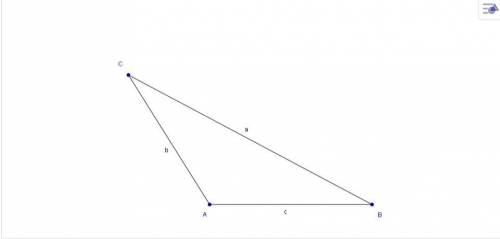
Mathematics, 14.04.2020 10:17 athenajames1221
Deriving the Area of an Obtuse Triangle You just derived the formula for the area of an acute triangle using trigonometric ratios. Now extend the idea to finding the area of an obtuse triangle. The Image needed is all the way in the bottom
Part A
Draw a line that passes through points A and B. Then draw a line through point C that is perpendicular to line AB . Label the intersection of the perpendicular line AB and as point D. Take a screenshot of your construction, save it, and insert the image in the space below.
Part B
What do you know about ΔBCD?
Part C
In terms of the trigonometric ratios for ΔBCD, what is the length of CD ? Insert text on the triangle in GeoGebra to show the length of CD . Take a screenshot of the triangle with the text, save it, and insert the image in the space below.
Part D
Using the formula 1/2 base x height, write an expression for the area of ΔABC. Base your answer on the work you did in parts A through C. Show your work.
Part E
Compare the formula for the area of the obtuse triangle in part D with the formula for the area of an acute triangle in task 1, part J. How do the formulas compare?
Part F
You found one formula, area of triangle = 1/2 acsin(B) , that applies to an obtuse triangle just as it does to an acute triangle. Which other formulas for the area of an obtuse triangle can you derive? Show the formulas and justify your answer. (Hint: See task 1, part K.)
Part G
Using your own words, describe the formula for the area of an obtuse triangle in word form.
Part H
Based on the formulas for an acute triangle in task 1 and the formulas for an obtuse triangle in task 2, can you draw a general conclusion about the area formulas for any kind of triangle: acute, obtuse, or right?


Answers: 1


Another question on Mathematics

Mathematics, 21.06.2019 14:10
Will give brainliest sum of arithmetic series (sigma notation) find the numerical answer to the summation given below. (image shown below)
Answers: 2

Mathematics, 21.06.2019 18:30
Which of the statements about the graph of the function y = 2x are true? check all of the boxes that apply. the domain is all real numbers x because the exponent of 2 can be any real number when the x-values increases by 1 unit, the y-value multiplies by 2. the y-intercept is (0, 1). the graph never goes below the x-axis because powers of 2 are never negative. the range is all real numbers.
Answers: 1

Mathematics, 21.06.2019 19:00
Jack did 3/5 of all problems on his weekend homework before sunday. on sunday he solved 1/3 of what was left and the last 4 problems. how many problems were assigned for the weekend?
Answers: 3

Mathematics, 21.06.2019 23:00
Describe the end behavior of the function below. f(x)=(2/3)^x-2 a. as x increases, f(x) approaches infinity. b. as x decreases, f(x) approaches 2. c. as x increases, f(x) approaches -2. d. as x decreases, f(x) approaches negative infinity.
Answers: 1
You know the right answer?
Deriving the Area of an Obtuse Triangle You just derived the formula for the area of an acute triang...
Questions



History, 12.10.2021 05:30

Mathematics, 12.10.2021 05:30

Business, 12.10.2021 05:30

Mathematics, 12.10.2021 05:30




Chemistry, 12.10.2021 05:40




Geography, 12.10.2021 05:40


Social Studies, 12.10.2021 05:40



Mathematics, 12.10.2021 05:40

English, 12.10.2021 05:40





